Abstract
The microstructures, mechanical properties, and anticorrosion properties of Fe–25Mn–Cr(12, 18 wt.%)–CN TWIP steels compared with nominal Fe–22Mn–0.6C TWIP steel (TWIP-ref) in the solid-solution state were investigated in the present study by using X-ray diffraction (XRD), electron backscattered diffraction (EBSD), transmission electron microscopy (TEM), tensile tests, and potentiodynamic polarization measurement, etc. The results show that the Fe–Mn–Cr–CN TWIP steels have excellent mechanical properties and anticorrosion properties compared to the TWIP-ref steel. The strain-hardening rate of the 12CrN steel is lower than that of the TWIP-ref steel because of the relatively late generation of high-density deformation twins, which resulted in less tensile strength increments during the tensile test. Moreover, M23C6 precipitates enriched with Mn and Fe formed in the Fe–Mn–Cr–CN steel as the Cr content increased, which had an important influence on the mechanical properties and anticorrosion properties. In the Fe–Mn–Cr–CN TWIP steels, because of the influence of the M23C6 precipitation in the 18CrN sample, the yield strength (σYS) is increased slightly, while the ultimate tensile strength (σUTS) and elongation to failure are decreased. In addition, 18CrN has poor corrosion resistance because of the formation of M23C6 precipitation (i.e., it has relatively negative corrosion potential (Ecorr) and a smaller corrosion current density (Icorr)).
1. Introduction
Twinning-induced plasticity (TWIP) steel is regarded as one of the structural materials with the most potential for automobiles because it meets the demands for safety and light weight, which are attributed to its excellent combination of high strength and high ductility [,,,,]. Fe–Mn–C-series [,,,] TWIP steel is one type of TWIP steel that has received widespread attention because of its hardening and strengthening mechanisms. Previous studies have confirmed that TWIP steels have outstanding mechanical properties that are attributable to their grain refinement by deformation-induced twinning, and to dynamic strain aging [,,]. The Fe–Mn–C system, with high Mn (15–25 wt.%) and C (0.4–1.0 wt.%) elements, possesses low stacking-fault energy (SFE) (20–40 mJ·m−2) and a full austenitic structure [,]. However, all TWIP steels, including the Fe–Mn–C system, have excellent mechanical properties but are they easily corroded. Therefore, the development of corrosion-resistant TWIP steel with high CrN content can greatly expand the applications of conventional Fe–Mn–C TWIP steels.
In an attempt to produce a TWIP steel with not only with excellent mechanical properties, but also with enhanced anticorrosion properties, a series of studies were conducted [,,,,,,,,], such as with N and/or Cr addition. Manganese is used as an austenite stabilizer and to provide the plasticity effect. Chromium is used to improve the corrosion resistance of the material. Cr has more positive electrode potential than Mn (i.e., the standard reduction potential of Cr ( V vs. standard hydrogen electrode (SHE)) and it is more positive than that of Mn ( V vs. SHE) [,]. Carbon and nitrogen are used as interstitial elements to obtain a stable austenitic structure. On the one hand, nitrogen improves the resistance to pitting corrosion [], and, on the other hand, the incorporation of chromium increases the solubility of the nitrogen in the melt during casting [].
Yuan et al. [] found that the amount of the intragranular precipitated phases of Cr23C6 increased with the increase in the Cr content (1.13~3.95 wt.%) in Fe–Mn–C–Al–Cr–N TWIP steels, and that the yields and ultimate tensile strengths were enhanced by increasing the Cr23C6 precipitation. Roncery et al. [] report a new series of Fe–Mn–Cr–C–N steels that were developed on the basis of thermodynamic calculations, and the results are fully austenitic microstructures without δ-ferrite or pores. The diffusion calculations that were made for the prediction of the diffusion annealing process indicate the tendency of C and N to cosegregate with Cr and Mn.
So far, there have been many studies on the microstructures and mechanical properties of TWIP steels. However, there are nearly no investigations that report the effect of high Cr content on the microstructures and properties of the Fe–Mn–C-system TWIP steels. It is expected that the present study will provide some new information for a better understanding of the relationship between the chromium content and the mechanical and anticorrosion properties of Fe–25Mn–Cr(12, 18)–CN TWIP steels. On the basis of this, we discuss the tensile properties and corrosion resistance in association with the microstructures and the M23C6 precipitates of TWIP steels that contain various contents of Cr.
2. Experimental Procedures
It has been reported [,,] that, in the Cr-alloyed TWIP steels, the contents of C and N, as well as the C/N ratio, are important factors to the increase in the solubility of the C in the austenite matrix. Therefore, suitable additions of C and N will not only guarantee the stability of the austenitic phase, but they will also keep the precipitation of the carbides that contain Cr from the austenitic matrix. On the basis of these findings, both the contents of C and N are set at 0.3 wt.% in the present TWIP steels. In addition, from the principle of corrosion resistance, the addition of Cr is usually 12 wt.% or more, and, thus, two additions of Cr were considered (i.e., 12 and 18 wt.%). Finally, the nominal composition (wt.%) of the current TWIP steels is Fe–25Mn–xCr–0.3C–0.3N (x = 12 and 18).
The TWIP steel was melted and cast in a 25 kg vacuum induction furnace under an argon atmosphere. After solidification, the ingots were heated to 1100 °C to ensure a homogenous microstructure, and they were then hot forged to round bars that were 40 mm in diameter. Before use, the round bars were annealed at 1100 °C for 4 h in order to obtain fully recrystallized grains and the necessary annealing twins. Finally, the annealed round bars were cut by an electric spark machine to form dog-bone-shaped tensile samples with a gauge size of 10 × 2.5 × 1.5 mm3. The measured composition is presented in Table 1.

Table 1.
The contents of main elements of TWIP steels (wt.%).
The tensile tests were carried out with a material test system (Instron 3369, Norwood, MA, USA) with a strain rate of 5 × 10−3 s−1 at room temperature. The phases were analyzed by an X-ray diffraction apparatus (XRD, X′Pert Pro MPD, PANalytical, Zwolle, Holland), using CuKα radiation with the scan angles from 20° to 100°, at a step of 0.03349°, at room temperature. The microstructures were observed and analyzed by electron backscattered diffraction (EBSD) equipment (HKL/Channel 5 system, Oxford Instruments, Bognor Regis, UK) and transmission electron microscopy (TEM, Tecnai G2 F20, FEI, Bryan, TX, USA). After they were mechanically ground and polished, the EBSD samples were electrolytically polished in a solution of 20% perchloric acid, 10% acetic acid and balanced ethanol by using 1~2 A of current and 20 V of voltage. The TEM samples were prepared by punching a disk sample first, with a diameter of 3 mm, from the tensile sample, and then mechanically thinning it down to 70 μm, and finally polishing it in a solution of 5% HClO4 and 95% C2H5OH at −25 °C by a double-jet electro-polishing apparatus. The mean grain size was measured by using the line intercept method on the EBSD inverse pole figure (IPF) maps, where all of the high-angle grain boundaries (HAGBs) and twin boundaries (TBs) were counted.
The corrosion behavior of the samples in 3.5 wt.% of NaCl solution was measured using potentiodynamic polarization tests (CHI 760E, Chenhua, China). A platinum electrode, a saturated calomel electrode (SCE), and the sample with an exposed area of 0.75 cm2 were separately used as the counter, the reference, and the working electrode, respectively. Before the test began, the working electrode was immersed in a 3.5 wt.% NaCl solution for one hour in order to obtain a stable surface state. The test was recorded at a scanning rate of 1.667 mV·s−1 at room temperature.
3. Results and Discussion
3.1. Influence of Cr on the Stacking-Fault Energy (SFE) of Alloy
The stacking-fault energy (SFE) can be calculated by the following equation [,]:
where is the molar surface density along the {111} planes; is the molar Gibbs energy related to the γ→ε phase transition; and σ is the interfacial energy between the γ and ε phases. The molar surface density () is determined by the lattice parameter (a) and Avogadro’s constant (A):
The for the FCC alloy steels is determined by the following equation:
where is the molar fraction of all the elements in the steel; is the changes in the Gibbs free energy; and is the interaction parameter between the i and j elements. If twinning deformation is to arise, the SFE of the steel should be in the range of 18 to 45 mJ/m2 [,].
In terms of the above equations, it is calculated that the SFE of 12CrN alloy is approximately 31mJ·m−2 []. In addition, Dumay et al. [] and Mosecker et al. [] studied the effect of the Cr contents on the SFE of TWIP steel by computational thermodynamics. on the basis of the thermodynamic stacking-fault energy (SFE) calculations, the SFEs of 12CrN and 18CrN are between 30 and 35 mJ·m−2. Therefore, the twinning deformation should be the predominant plastic mechanism in the present TWIP steels (i.e., when the content is equal or below 18 wt.%, the Cr addition will not change the plastic deformation modes of TWIP steels).
3.2. Influence of Cr on the Microstructures of Alloy
The XRD spectra of the samples in the solid-solution state before and after the tensile tests are shown in Figure 1 and Figure 2, respectively. Only the austenite phase existed in the microstructures, which verifies that the austenite is stable in the present alloys. From Figure 2, it is seen that the γ(111), γ(200), and γ(220) peaks are very strong, while the γ(311) and γ(222) peaks are quite weak, which suggests that there are preferential orientations of the γ phase during the tensile deformation.
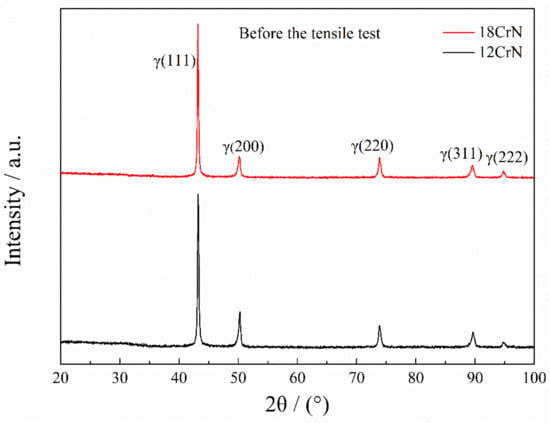
Figure 1.
XRD patterns of Fe–Mn–Cr–CN TWIP steels before the tensile test.
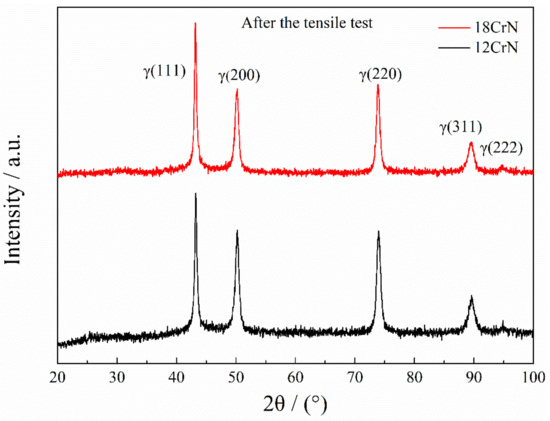
Figure 2.
XRD patterns of Fe–Mn–Cr–CN TWIP steels after the tensile test.
Figure 3 presents the inverse pole figure (IPF) maps of the samples that were obtained by the EBSD analysis. It can be seen that there are many annealing twins that appear in the samples, which are similar to those in the common TWIP steels without the Cr addition. Therefore, it is suggested that an addition of Cr up to 18 wt.% does not affect the stability of the austenite and the twinning behavior of TWIP steels.
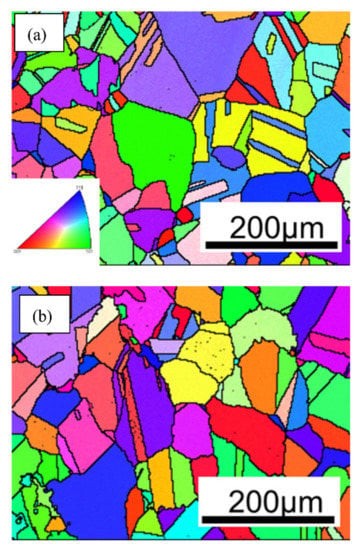
Figure 3.
IPF maps of Fe–Mn–Cr–CN TWIP steels: (a) 12CrN; and (b) 18CrN.
3.3. Influence of Cr on the Mechanical Properties of Alloys
Figure 4 shows the engineering stress–strain curves of the TWIP steels, with or without the Cr addition, and the typical properties are listed in Table 2. It is obvious that, when the Cr content was 12 wt.%, the alloy showed the best overall mechanical properties among the three TWIP steels. The average yield and tensile strength are 496 MPa and 904 MPa, respectively, and the average elongation is 67.2%. As a comparison, the common TWIP steel shows a yield strength of 308 MPa, a tensile strength of 890 MPa, and an elongation of 63.4%. All of the properties are lower than those of the 12CrN TWIP steel. On the other hand, by increasing the Cr content to 18 wt.%, the elongation of the TWIP steel decreased, although the strength still maintained relatively high values.
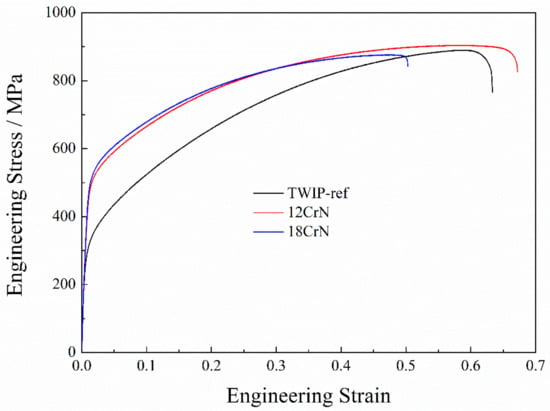
Figure 4.
The engineering stress–strain curves of Fe–Mn–Cr–CN steel compared to TWIP-ref steel.

Table 2.
Tensile properties of Fe–Mn–Cr–CN steel in comparison to TWIP-ref steel.
Figure 5 shows the TEM images of the 12CrN and 18CrN samples in the solution state, and they all have relatively low-density dislocations with significant twins. Figure 6 shows the precipitation, the inset diffraction pattern, and the EDS analysis of the 18Cr TWIP steel in a solution state. From the results of the EDS analysis and the diffraction pattern, the precipitation was identified as M23C6 enriched with Mn and Fe.
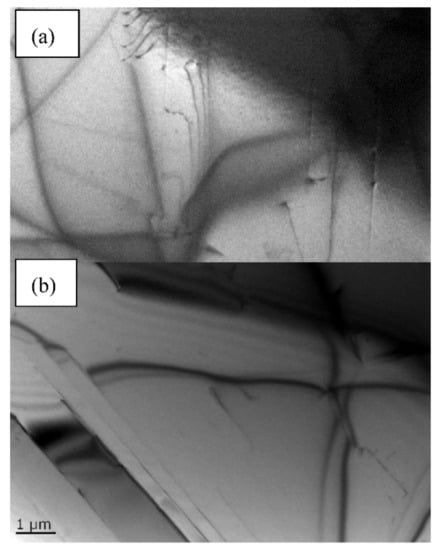
Figure 5.
TEM images of Fe–Mn–Cr–CN TWIP steels: (a) 12CrN; and (b) 18CrN.
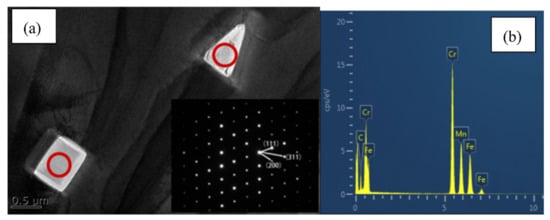
Figure 6.
M23C6 precipitates enriched with Mn and Fe in 18CrN sample: (a) TEM and diffraction pattern; and (b) EDS analysis.
There have been many studies on nitrogen solid-solution strengthening to increase the yield strength [,,,]. Roncery et al. [] mention that nitrogen is 1.5 times more effective than carbon as a strengthening element in austenitic steels. Rawers et al. [] propose an equation for solid-solution strengthening (σs) by elemental N: , where [N] is the nitrogen concentration (wt.%). Wang et al. [] studied chromium/nitrogen alloying to improve the yield strength of Fe–Mn–C TWIP steel, and they found that AlN precipitation refined the grain size of the studied steel and yielded greater precipitation strengthening.
The yield strengths of the 12CrN and 18CrN samples are 496 and 512 MPa, respectively, which are much higher than the 308 MPa of the TWIP-ref sample. The carbon element in the 12CrN and 18CrN samples is 0.32 and 0.28 wt.%, respectively, which is far lower than the 0.52 wt.% in the TWIP-ref sample. However, the N contents in the 12CrN and 18CrN samples reached up to 0.31 and 0.32 wt.%, respectively. Considering that the solid-solution strengthening effect of N is 1.5 times that of C [] (that is, the corresponding C contents are 0.465 and 0.48 wt.%, respectively), so the carbon contents that represent the total interstitial element (C + N) contents of the 12CrN and 18CrN samples are 0.785 and 0.76 wt.%, respectively, which are much higher than the TWIP-ref sample. It can be concluded that the yield strength of Fe–Mn–Cr–CN TWIP steel is significantly higher than that of TWIP-ref steel.
The nominal interstitial element content of 18CrN (carbon content represents total interstitial content) is 0.76 wt.%, which is lower than the 0.785 wt.% of 12CrN. According to the theory of interstitial-element solid-solution strengthening, the yield strength of 18CrN should be lower than that of 12CrN. However, the experimental results show that the yield strength of 18CrN is 512 MPa, which is slightly higher than that of 12CrN (496 MPa). Zheng et al. [] found that the precipitation of M23C6 carbides increased the strength modestly and deteriorated the ductility significantly in 0.3C–20Cr–11Mn–1Mo–0.35N steel. Therefore, M23C6 precipitates formed in the 18CrN sample (Figure 6), which resulted in its higher yield strength. Because of the influence of the M23C6 precipitation, the elongation to failure of 18CrN (50.3%) is significantly worse than that of 12CrN (67.2%). In addition, the average grain size of the 18CrN sample is 37.7 μm, which is lower than the 38.1 μm of 12CrN. According to the Hall–Petch relation [,] (, where σYS is the yield strength; σ0 is the resistance of the lattice to the dislocation motion; K is the strengthening coefficient; and d is the average grain size), the smaller the average grain size, the higher the yield strength.
Figure 7 shows the strain-hardening rate against the true strain curves of the TWIP-ref, 12CrN, and 18CrN samples in the solution state. It can be seen that the TWIP-ref sample shows a very different strain-hardening rate vs. true strain (i.e., the strain-hardening rate in the intermediate stage is, at first, kept constant, with an increase in the true strain from 8 to 28%, and then the strain-hardening rate slowly dropped with the increase in the true strain). However, the 12CrN and 18CrN samples showed very similar tendencies of the strain-hardening rate with the increasing true strain. There were three steps in the strain-hardening-rate curve: the strain-hardening rate dropped almost vertically at the beginning and at the end, and it dropped more slowly in the intermediate stage of deformation. The strain-hardening-rate curves of the 12CrN and 18CrN samples are very similar, which indicates that the increase in the Cr content from 12 to 18 wt.% hardly affects the deformation mechanism of Fe–Mn–Cr–CN TWIP steel. Moreover, the strain-hardening rate of Fe–Mn–Cr–CN TWIP steel is significantly lower than that of the TWIP-ref steel. This implies that there will be two distinct deformation behaviors between TWIP-ref and Fe–Mn-Cr–CN TWIP steel.
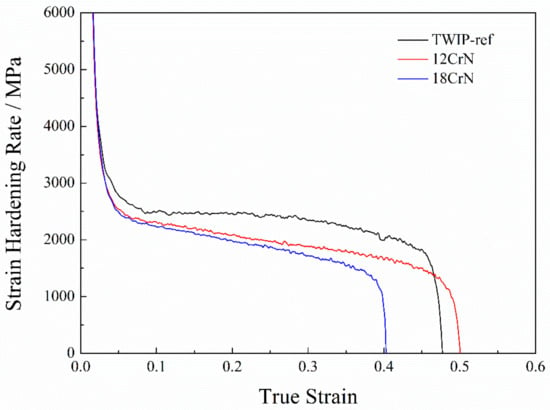
Figure 7.
Strain-hardening rates against true strain of Fe–Mn–Cr–CN and TWIP-ref steels.
Figure 8 shows the TEM images of the deformation of the studied steels. High-density mechanical twins are observed in the TWIP-ref steel that was deformed to 0.15, and the thickness of the observed twin lamella ranges from 3 to 30 nm (Figure 8a). However, for the 12CrN steel, only parallel high-density dislocation walls (HDDWs) were observed in the steel that was deformed to 0.15 (Figure 8b); high-density mechanical twins are observed in the steel when the strain is further increased to 0.45, and the thickness of the twin lamella ranges from 3.5 to 35 nm (Figure 8c). During tensile deformation, the twinning behavior of 12CrN steel is not as obvious as that of TWIP-ref steel, and, hence, the former generated fewer twin boundaries (TBs) than the latter during the tensile test, which resulted in the poorer hindering effect on the dislocations than that of the latter, and which resulted in less tensile strength increments during the tensile test, which explains why the strain-hardening rate of the 12CrN steel is significantly lower than that of the TWIP-ref steel (Figure 7). The representative tensile fracture features of the 12CrN and 18CrN samples are presented in Figure 9. The profiles exhibit many refined dimples, which are typical ductile fracture characteristics, and which also indicate that there is no effect on the fracture mechanism in Fe–Mn–Cr–CN TWIP steel with large amounts of Cr content from 12 to 18 wt.%.
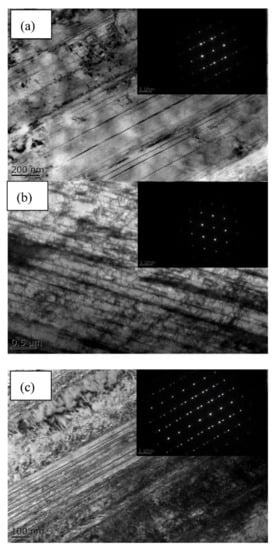
Figure 8.
TEM images of deformation studied steels: (a) TWIP-ref deformed to 0.15; (b) 12CrN deformed to 0.15; and (c) 12CrN deformed to 0.45.
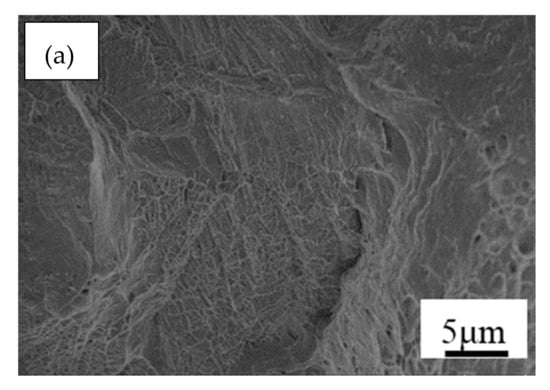
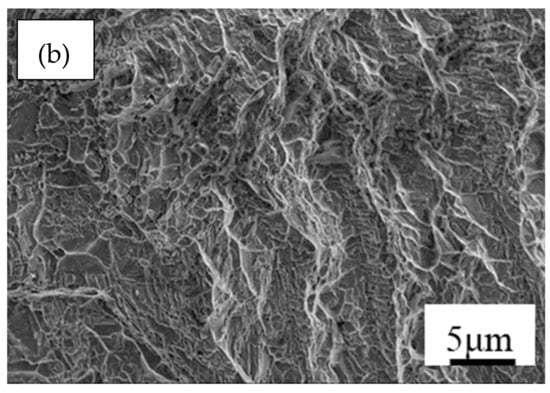
Figure 9.
The fracture morphologies after tensile test of Fe–Mn–Cr–CN TWIP steels: (a) 12CrN; and (b) 18CrN.
3.4. Influence of Cr on the Corrosion Resistance of Alloy
Figure 10 shows the potentiodynamic polarization curves of the samples in 3.5 wt.% of NaCl solution, and the relevant corrosion potential (Ecorr) and corrosion current density (Icorr) data are listed in Table 3. In these experiments, each polarization test was repeated at least three times until stable values were reached, and the data that are shown in Figure 10 and Table 3 are the representative results.
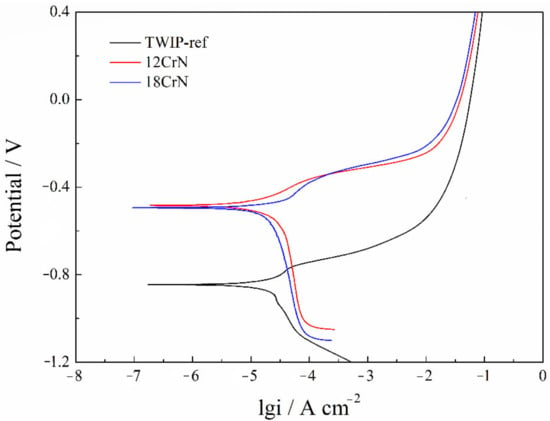
Figure 10.
Potentiodynamic polarization curves of Fe–Mn–Cr–CN and TWIP-ref samples.

Table 3.
Characteristic data obtained from polarization curves.
It can be seen from Figure 10 and Table 3 that the corrosion-resistant properties of the samples containing Cr are much better than those of the common TWIP steel sample. The corrosion potential (Ecorr) of the common TWIP steel is −845 mV, while the Ecorr values of the samples with 12Cr and 18Cr are −483 and −494 mV, respectively. In terms of the standard reduction potential, Cr has a standard reduction potential of −0.74 V at a standard hydrogen electrode, while Mn has a standard reduction potential of only −1.18 V [,]. On the other hand, the corrosion current density (Icorr) of the TWIP steel containing 12Cr is 1.4707 × 10−6 A·cm−2, while that of the common TWIP steel is 2.9027 × 10−6 A·cm−2. The former has a much lower corrosion current density than the latter. Therefore, the Cr addition is significantly beneficial for improving the corrosion-resistant properties of TWIP steels.
It can be noticed that, when the Cr content is increased to 18 wt.%, the corrosion resistance of the TWIP steel was, instead, decreased. The Ecorr shifted towards the negative and the Icorr increased to a much larger positive value. In order to understand this change, the microstructures of the 18CrN samples were further analyzed. It was found that there were many small (Fe, Cr)23C6 carbides in the microstructures of the 18CrN samples, as is shown in Figure 6. It would be reasonable to assume that the precipitation of the carbides that contained Cr not only reduced the Cr content of the austenite matrix, but also increased the phase interfaces. Both the changes are unfavorable for the corrosion resistance of TWIP steels.
4. Conclusions
The microstructures, mechanical properties, and anticorrosion properties of Fe–Mn–Cr–CN TWIP steels, compared to a TWIP-ref steel solution treated at 1100 °C for 4 h, were investigated in the present study. The following conclusions were obtained:
- (1)
- The Fe–Mn–Cr–CN TWIP steels still had the stable single austenite phase before and after the tensile test, even with Cr contents as high as 12 and 18 wt.%;
- (2)
- Compared with the TWIP-ref steel, the Fe–Mn–Cr–CN TWIP steels have better mechanical properties and corrosion resistance. The strain-hardening rate of 12CrN steel is lower than that of the TWIP-ref steel because of the relatively late generation of high-density deformation twins, which resulted in less tensile strength increments during the tensile test. The yield strengths of the 12CrN and 18CrN samples are 496 and 512 MPa, respectively, which are much higher than that of the TWIP-ref sample (308 MPa). Moreover, the Fe–Mn–Cr–CN steels have more excellent anticorrosion properties. The Ecorr values of the 12CrN and 18CrN samples are −483 and −494 mV, respectively, which are more positive than that of the TWIP-ref sample (−845 mV), and the Icorr of the 12CrN sample (1.4707 × 10−6 A·cm−2) is significantly smaller than that of the TWIP-ref sample (2.9027 × 10−6 A·cm−2);
- (3)
- The higher Cr content of the 18CrN sample leads to the precipitation of M23C6, which is harmful to the ductility and corrosion resistance of Fe–Mn–Cr–CN TWIP steels. Therefore, compared to the 12CrN sample, the 18CrN sample has poor ductility and anticorrosion properties.
Author Contributions
Conceptualization, Y.S. and F.H.; methodology, Y.S. and F.H.; validation, X.W. and J.L.; formal analysis, X.W.; investigation, Y.S.; resources, F.H.; data curation, J.L.; writing—original draft preparation, Y.S.; writing—review and editing, F.H.; visualization, Y.S., X.W. and J.L.; supervision, F.H.; project administration, F.H.; funding acquisition, F.H. All authors have read and agreed to the published version of the manuscript.
Funding
This work was jointly supported by the National Natural Science Foundation of China (No. 52001304, No. 51701206, No. 51671187), the Anhui Province Science Foundation for Youths (No. 2008085QE259), and the Foundation of President of Hefei Institutes of Physical Science, Chinese Academy of Sciences (No. YZJJ201703).
Institutional Review Board Statement
Not applicable.
Informed Consent Statement
Not applicable.
Data Availability Statement
Data sharing is not applicable.
Conflicts of Interest
The authors declare no conflict of interest.
References
- Kim, S.H.; Kim, H.; Kim, N.J. Brittle intermetallic compound makes ultrastrong low-density steel with large ductility. Nature 2015, 518, 77–79. [Google Scholar] [CrossRef]
- Grassel, O.; Frommeyer, G. Effect of martensitic phase transformation and deformation twinning on mechanical properties of Fe–Mn–Si–Al steels. Mater. Sci. Technol. 1998, 14, 1213–1217. [Google Scholar] [CrossRef]
- Steinmetz, D.R.; Japel, T.; Wietbrock, B.; Eisenlohr, P.; Gutierrez-Urrutia, I.; Saeed-Akbari, A.; Hickel, T.; Roters, F.; Raabe, D. Revealing the strain-hardening behavior of twinning-induced plasticity steels: Theory, simulations, experiments. Acta Mater. 2013, 61, 494–510. [Google Scholar] [CrossRef]
- Yang, G.; Kim, J.-K. An overview of high yield strength twinning-induced plasticity steels. Metals 2021, 11, 124. [Google Scholar] [CrossRef]
- Idrissi, H.; Renard, K.; Schryvers, D.; Jacques, P.J. On the relationship between the twin internal structure and the work-hardening rate of TWIP steels. Scr. Mater. 2010, 58, 961–964. [Google Scholar] [CrossRef]
- Bouaziz, O.; Allain, S.; Scott, C. Effect of grain and twin boundaries on the hardening mechanisms of twinning-induced plasticity steels. Scr. Mater. 2008, 58, 484–487. [Google Scholar] [CrossRef]
- Yang, H.K.; Tian, Y.Z.; Zhang, Z.J.; Zhang, Z.F. Simultaneously improving the strength and ductility of Fe–22Mn-0.6C twinning-induced plasticity steel via nitrogen addition. Mater. Sci. Eng. A 2018, 715, 276–280. [Google Scholar] [CrossRef]
- Torganchuk, V.; Belyakov, A.; Kaibyshev, R. Improving mechanical properties of 18%Mn TWIP steels by cold rolling and annealing. Metals 2019, 9, 776. [Google Scholar] [CrossRef] [Green Version]
- Jeong, K.; Jin, J.E.; Jung, Y.S.; Kang, S.; Lee, Y.K. The effects of Si on the mechanical twinning and strain hardening of Fe–18Mn-0.6C twinning-induced plasticity steel. Acta Mater. 2013, 61, 3399–3410. [Google Scholar] [CrossRef]
- Lan, P.; Tang, H.; Zhang, J. Hot ductility of high alloy Fe–Mn–C austenite TWIP steel. Mater. Sci. Eng. A 2016, 660, 127–138. [Google Scholar] [CrossRef]
- Yang, H.K.; Zhang, Z.J.; Zhang, Z.F. Comparison of work hardening and deformation twinning evolution in Fe–22Mn–0.6C–(1.5Al) twinning-induced plasticity steels. Scr. Mater. 2013, 68, 992–995. [Google Scholar] [CrossRef]
- Saeed-Akbari, A.; Imlau, J.; Prahl, U.; Bleck, W. Derivation and variation in composition-dependent stacking fault energy maps based on subregular solution model in high-manganese steels. Metall. Mater. Trans. A 2009, 40A, 3076–3090. [Google Scholar] [CrossRef]
- Allain, S.; Chateau, J.P.; Bouaziz, O.; Migot, S.; Guelton, N. Correlations between the calculated stacking fault energy and the plasticity mechanisms in Fe–Mn–C alloys. Mater. Sci. Eng. A 2004, 387–389, 158–162. [Google Scholar] [CrossRef]
- Yuan, X.; Zhao, Y.; Li, X.; Chen, L. Effect of Cr on mechanical properties and corrosion behaviors of Fe–Mn–C–Al–Cr–N TWIP steels. J. Mater. Sci. Technol. 2017, 33, 1555–1560. [Google Scholar] [CrossRef]
- Mujica, L.; Weber, S.; Theisen, W. Development of high-strength corrosion-resistant austenitic TWIP steel. Metall. Ital. 2011, 6, 31–35. [Google Scholar]
- Roncery, L.M.; Weber, S.; Theisen, W. Development of Mn-Cr-(C-N) corrosion resistant twinning induced plasticity steels: Thermodynamic and diffusion calculation, production, and characterization. Metall. Mater. Trans. A 2010, 41A, 2471–2479. [Google Scholar] [CrossRef]
- Berns, H.; Gavriljuk, V.G.; Riedner, S.; Tyshchenko, A. High strength stainless austenitic CrMnCN steels—Part I: Alloy design and properties. Steel Res. Int. 2007, 78, 714–719. [Google Scholar] [CrossRef]
- Roncery, L.M.; Weber, S.; Theisen, W. Mechanical properties of (20–30)Mn12Cr(0.56–0.7)CN corrosion resistant austenitic TWIP steels. Steel Res. Int. 2012, 83, 307–314. [Google Scholar] [CrossRef]
- Bastidas, D.M.; Ress, J.; Bosch, J.; Martin, U. Corrosion mechanisms of high-Mn twinning-induced plasticity (TWIP) steels: A critical review. Metals 2021, 11, 287. [Google Scholar] [CrossRef]
- Fajardo, S.; Llorente, I.; Jiménez, J.A.; Calderón, N.; Herrán-Medina, D.; Bastidas, J.M.; Ress, J.; Bastidas, D.M. Influence of chromium on the passivity of thermo-mechanically processed high-Mn TWIP steels. Appl. Surf. Sci. 2020, 513, 1–9. [Google Scholar] [CrossRef]
- Witusiewicz, V.T.; Sommer, F.; Mittemeijer, E.J. Reevaluation of the Fe–Mn phase diagram. J. Phase Equilib. Diff. 2004, 25, 346–354. [Google Scholar] [CrossRef]
- Dai, J.; Feng, H.; Li, H.-B.; Jiang, Z.-H.; Li, H.; Zhang, S.-C.; Zhou, P.; Zhang, T. Nitrogen significantly enhances corrosion resistance of 316L stainless steel in thiosulfate-chloride solution. Corros. Sci. 2020, 174, 1–11. [Google Scholar] [CrossRef]
- Dumay, A.; Chateau, J.-P.; Allain, S.; Migot, S.; Bouaziz, O. Influence of addition elements on the stacking-fault energy and mechanical properties of an austenitic Fe–Mn–C steel. Mater. Sci. Eng. A 2008, 483–484, 184–187. [Google Scholar] [CrossRef]
- Curtze, S.; Kuokkala, V.-T. Dependence of tensile deformation behavior of TWIP steels on stacking fault energy, temperature and strain rate. Acta Mater. 2010, 58, 5129–5141. [Google Scholar] [CrossRef]
- Allain, S.; Chateau, J.-P.; Bouaziz, O. A physical model of the twinning-induced plasticity effect in a high manganese austenitic steel. Mater. Sci. Eng. A 2004, 387–389, 143–147. [Google Scholar] [CrossRef]
- Mosecker, L.; Saeed-Akbari, A. Nitrogen in chromium-manganese stainless steels: A review on the evaluation of stacking fault energy by computational thermodynamics. Sci. Technol. Adv. Mater. 2013, 14, 1–14. [Google Scholar] [CrossRef] [PubMed]
- Rawers, J.; Grujicic, M. Effects of metal composition and temperature on the yield strength of nitrogen strengthened stainless steels. Mater. Sci. Eng. A 1996, 207, 188–194. [Google Scholar] [CrossRef]
- Wang, W.J.; Sun, X.J.; Song, C.; Chen, H.; Han, W.; Pan, F. Enhancement of yield strength by chromium/nitrogen alloying in high-manganese cryogenic steel. Mater. Sci. Eng. A 2017, 698, 110–116. [Google Scholar] [CrossRef]
- Zhang, S.; Liu, K.; Chen, H.; Xiao, X.; Wang, Q.; Zhang, F. Effect of increased N content on microstructure and tensile properties of low-C V-microalloyed steels. Mater. Sci. Eng. A 2016, 651, 951–960. [Google Scholar] [CrossRef]
- Zheng, L.; Hu, X.; Kang, X.; Li, D. Precipitation of M23C6 and its effect on tensile properties of 0.3C–20Cr–11Mn–1Mo–0.35N steel. Mater. Des. 2015, 78, 42–50. [Google Scholar] [CrossRef]
- Hall, E.O. The deformation and ageing of mild steel: III discussion of results. Proc. Phys. Soc. Sect. B 1951, 64, 747–753. [Google Scholar] [CrossRef]
- Petch, N.J. The cleavage strength of polycrystals. J. Iron Steel Inst. 1953, 174, 25–28. [Google Scholar]
Publisher’s Note: MDPI stays neutral with regard to jurisdictional claims in published maps and institutional affiliations. |
© 2022 by the authors. Licensee MDPI, Basel, Switzerland. This article is an open access article distributed under the terms and conditions of the Creative Commons Attribution (CC BY) license (https://creativecommons.org/licenses/by/4.0/).